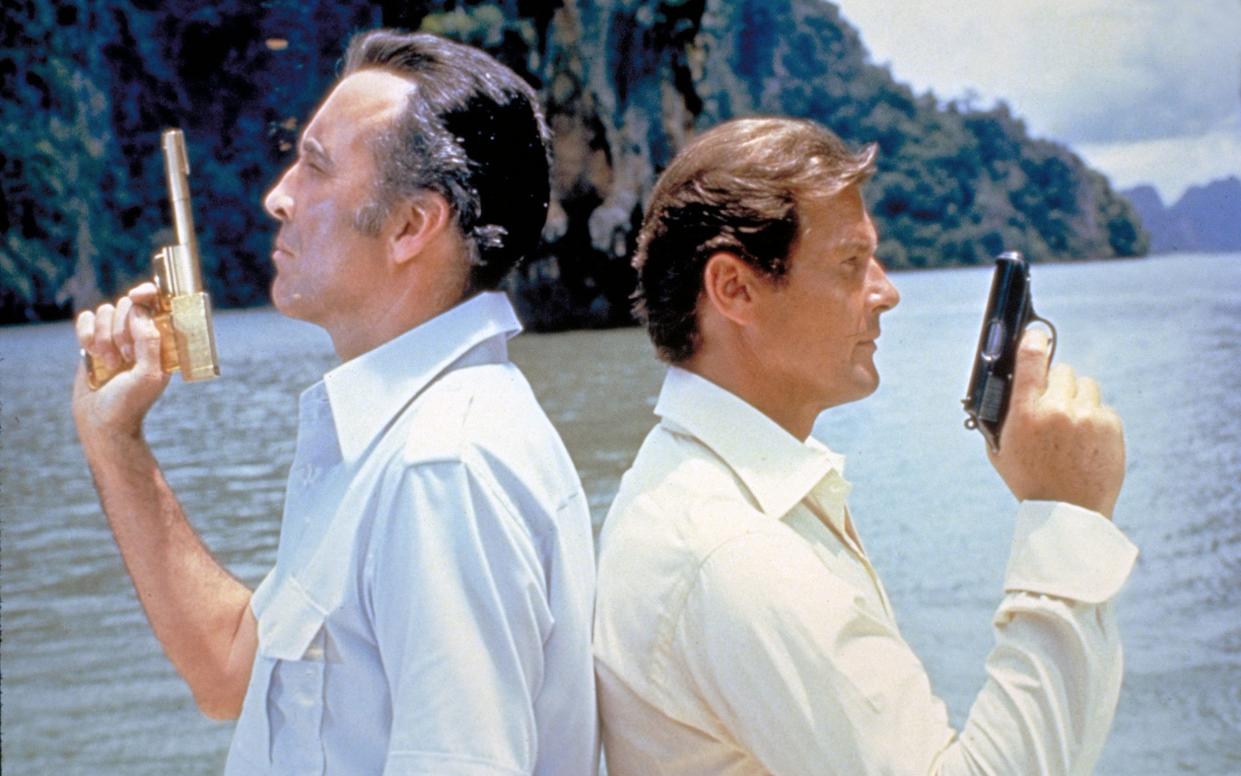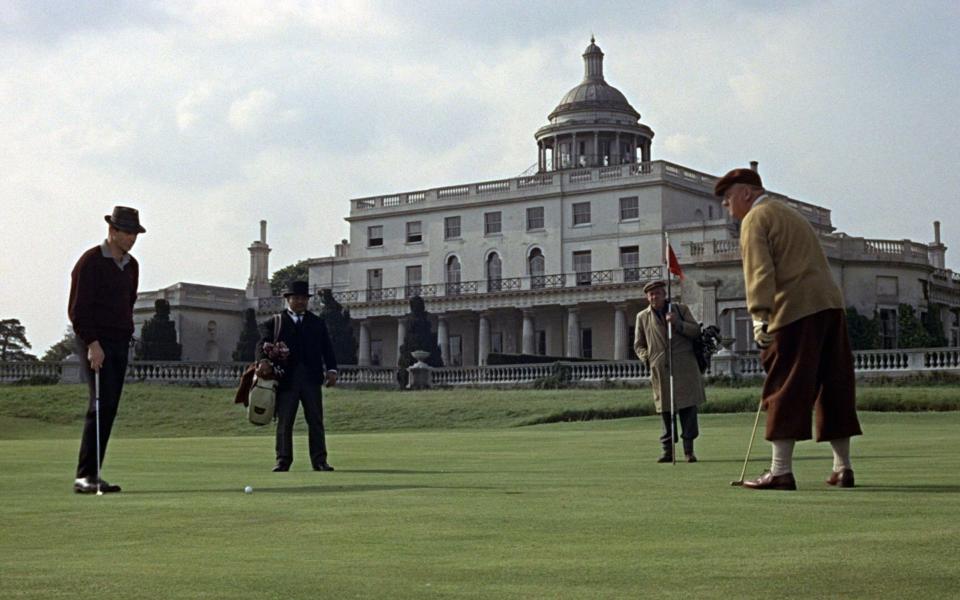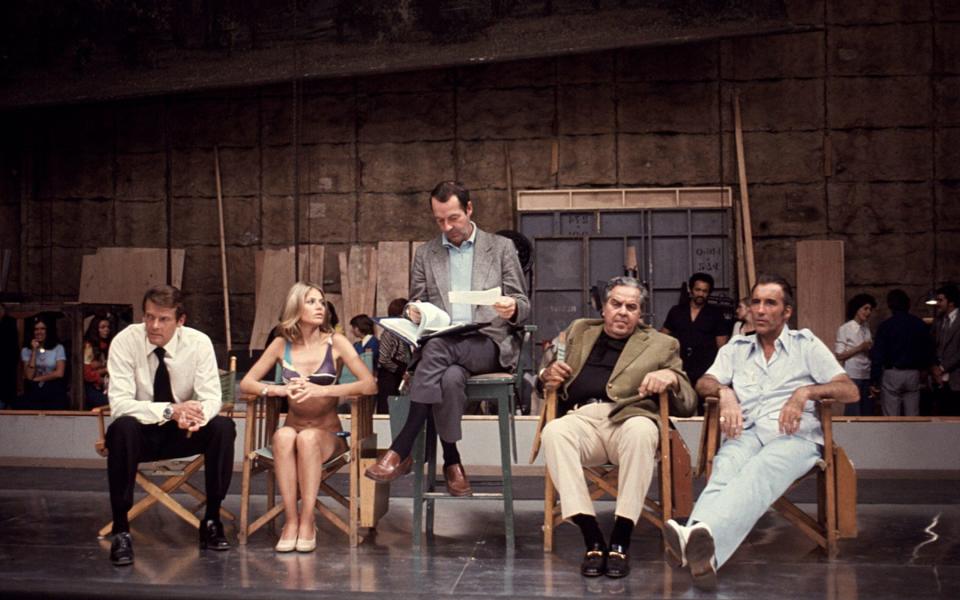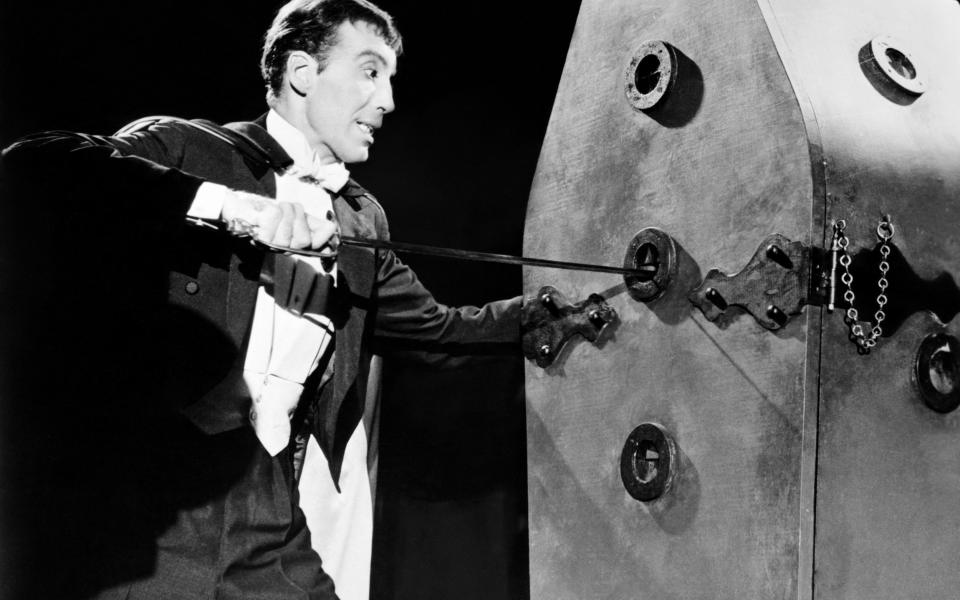How Christopher Lee made The Man With the Golden Gun Bond’s most menacing, majestic villain

“Come, come, Mr Bond… you get as much fulfillment out of killing as I do.” As lines from baddies go – in this case, Sir Christopher Lee’s Scaramanga – it’s solid gold, 24-carat Bond villainy. The moment comes in The Man with The Golden Gun, as Scaramanga lunches with Roger Moore’s 007 on his exotic island-cum-secret lair. It’s a prelude to a fight to the death. They’re exchanging notes on vintage plonk for now – as served by 3’11” henchman Nick Nack (Hervé Villechaize) – but they’ll be duelling by the afternoon: Bond’s Walther PPK vs. Scaramanga’s golden gun.
Steve Coogan and Rob Brydon mimicked the scene in The Trip – impersonating Bond (competitively) over lunch – confirming its status as top-tier Bond banter. But The Man with The Golden Gun, which was released in 1974 and briefly returns to cinemas this Friday, remains a poorly rated entry.
It took some shine off 007 with underwhelming box office and less-than-glittering reviews (“Bond loses golden touch” complained one headline about Moore’s second outing). Even now, the popular James Bond fan site MI6 HQ rates the film just 3/10 stars. Everything or Nothing, the celebratory Bond documentary from 2012, took aim at the film’s uneven tone, which it blamed on behind-the-scenes discord between producing partners Cubby Broccoli and Harry Saltzman.
“It gets a hard time,” says Matthew Field, co-author of Some Kind of Hero, the definitive history of Bond films. “But I think The Man with The Golden Gun is the most underrated Bond film… it has all the elements you want from a Bond film. It’s got an incredibly exotic location, a mysterious villain, an interesting henchman and a jaw-dropping centrepiece stunt – the corkscrew car jump.”
Best of all is Scaramanga himself – Sir Christopher Lee – who remains, regardless of the film’s popularity, the finest, most majestic Bond villain of them all.
If Bond’s adversaries tend to play two roles – dark mirror images of Bond himself, or power-mad megalomaniacs – Scaramanga is both: Bond’s equal in sophistication, shooting skills, and physical prowess (“To us, Mr Bond,” he says, raising a glass. “We are the best.”); but also, a lunatic with a solar-powered laser. Scaramanga plans to corner the energy market with solar technology – or hold the oil industry to ransom. Indeed, in the current energy and cost of living crisis, Scaramanga would have been living the high life with his solar power monopoly.
Bond hadn’t met a physical match like Scaramanga since fighting Red Grant (Robert Shaw) in From Russia with Love – his fisticuffs with Connery are still the standard to beat. “After that, Bond had these villains who were fabulous and iconic – Largo, Blofeld, Mr Big,” says Matthew Field. “They were megalomaniac villains hiding in big bases with grand plans. But you know that in a fight, when it came down to it, James Bond was going to win. Christopher Lee as Scaramanga was a believable physical threat to 007. He was both athletic and menacing.”
As Field says, Christopher Lee was almost destined to play a Bond villain. Best remembered as Dracula or Lord of the Rings’ Saruman (depending on your age), Lee was the step-cousin and golf buddy of Bond creator Ian Fleming. As Lee recalled in his autobiography, Fleming offered him the role of Dr No in the very first Bond film. The producers, however, cast Joseph Wiseman instead. “And he proved to be class slime,” wrote Lee.
Lee wondered if Dr No’s steel prosthetic hands – mechanical pincers in the book – were inspired by The Hands of Orlac, a hand transplant horror film that starred Lee. And Dr No, he observed, was “a sinister Oriental, as I had been often enough”, referencing his Fu Manchu films. The way Lee told it – embellishing his role in Bond history, perhaps – he might have inspired the entire Bond villain archetype. Even the golf course where Fleming and Lee played together – Royal St. George’s in Sandwich, Kent – inspired the tee-off between Bond and Goldfinger, the basis for a key Bond vs. villain trope: the mano-a-mano sporting contest.

Indeed, Bond has competed with villains in various games: pheasant hunting (Moonraker); horse racing (A View to a Kill); fencing (Die Another Day); cards (Casino Royale); and target practice (Skyfall). The Man with The Golden Gun concludes with the ultimate game of macho one-upmanship – a pistols at dawn-style duel around Scaramanga’s own personal funhouse. First one to die loses.
Published posthumously in 1965 – less than a year after Fleming’s death – The Man with The Golden Gun was the final James Bond novel. It’s widely regarded as a lesser entry. (Even director Guy Hamilton admitted they were “scraping the barrel”.)
The story’s villain, Francisco “Pistols” Scaramanga, was named after a school friend of Fleming’s. Or a school-enemy perhaps – Fleming apparently fought with the real Scaramanga at Eton. Being named after a school chum is actually a good pedigree for a Bond villain: his arch-nemesis, Ernst Stavro Blofeld, was also named after another of Fleming’s school pals – the father of cricket commentator Henry Blofeld.
The Man with The Golden Gun went into production hastily – less than a year after the release of Moore’s first Bond film, Live and Let Die. Jack Palance was offered the role of Scaramanga but declined. Guy Hamilton then offered the role to Christopher Lee over lunch. The book version of Scaramanga, said Lee, was “a great ox of a man” and “really just a thug”. But Lee revelled in the film version – the best written villain since Goldfinger, recalled Lee in his autobiography.
Filmed between Thailand, Macau, and Hong Kong, the film sees Bond on a mission to kill Scaramanga, the world’s greatest, most mysterious assassin. Charging £1 million per hit, Scaramanga is recognised only by his third nipple (“Fascinating anatomical titbit,” says Bond) and his quick-to-assemble gold pistol (which unscrews into a pen, cufflink, cigarette case, and lighter).

Cast alongside Roger Moore and Christopher Lee were Maud Adams as Andrea Anders, Scaramanga’s abused mistress; Hervé Villechaize as mini, murderous butler Nick Nack, pitched as an opposite to Goldfinger’s hat-throwing Oddjob; and Britt Ekland as Mary Goodnight, the most useless agent in the history of the Cold War.
With Bond’s sexism at eyebrow-raising levels, the feeble-minded Goodnight is subjected to the worst of Roger’s cringey condescension. At one point she’s kicked out of bed and locked in the closet – so Bond can have his way with Maud Adams’ Andrea instead. “Forgive me, darling,” says Bond, consoling the jilted, stroppy Goodnight. “Your turn will come, I promise.”
The Man with The Golden Gun was a significant film – the last to be produced by both Albert ‘Cubby’ Broccoli and Harry Saltzman, whose relationship had broken down. Saltzman’s most amusing contribution was insisting that the film should include an elephant stampede, for which he ordered 200 elephant shoes (the scene never happened). Saltzman soon had a messy financial divorce from Bond.
As detailed in the Everything or Nothing documentary, there is something oddly out-of-synch in The Man with The Golden Gun (whether it was the fault of Broccoli and Saltzman or not). In one scene, Bond slaps around Andrea, which just doesn’t feel like Roger’s kind of caper (patronising sexism, yes; man-on-woman violence, no). “They tried to make him look like Sean [Connery],” said Maud Adams about the scene. “It didn’t work at all, in my opinion.”

Adams’ character, however, does cast a dark, sombre shadow over the film. Kept by Scaramanga only to have sex before his next kill – simply to get his blood pumping – she offers herself to Bond so he’ll kill Scaramanga and free her from his abuse. Scaramanga then shoots her dead for her betrayal. In a later, darker era, that might have been a point of deep introspection for Bond – a hefty guilt to hang around his neck. Here, both hero and villain simply carry on in their contest of who’s the best man. “Forget the girl,” says Scaramanga, “she’s replaceable.”
There is plenty of Rodge-style silliness: Scaramanga’s flying car (based on a real car with wings); some choice one-liners (“Speak now,” says Bond, pointing a gun at some chap’s crotch, “or forever hold your piece”); and the return of comedy irritant JW Pepper (Clifton James), the Louisiana sheriff inexplicably brought back from Live and Let Die.
Most ludicrous is the slide-whistle sound effect used over the film’s signature stunt – an AMC Hornet corkscrew jump over the Mae Klong River. The slide-whistle would be better suited to Kenneth Williams’ bloomers falling down in a Carry On film. Whatever the legendary Bond composer John Barry was thinking will remain one of the great Bondian mysteries, like why villains feel obliged to explain their grand plans instead of simply shooting 007 in the head – a mistake that Scaramanga repeats.
The stunt, performed by Loren “Bumps” Willard, was designed by a computer that simulated car crashes. To execute the jump, the car had to be perfectly weighted, with the steering wheel in the middle, so it was cut in half and reconfigured. It was highly dangerous. If the jump went wrong, Willard – actually laying down on his front, with the pedals behind him – would have plunged into the river while strapped in. It was done in one take. “It may be ruined by the slide whistle sound effect but that AMC Hornet stunt is amazing,” says Matthew Field. “It was the first time that computers were used to program a stunt. Look at it now and you might think it looks like model work – it’s so amazingly perfect you almost don’t believe it.”

The stunt looked so perfect, in fact, that Guy Hamilton wanted to do it again. Bumps Willard told him no. It was the first time he had performed the jump and it had gone perfectly. He wouldn’t be doing it again.
The slide-whistle is unforgivably daft, but Christopher Lee enjoyed the light touch of director Guy Hamilton. “He got the Dracula out of me,” said Lee, who by 1974 had starred in dozens of horror films. But there is a sinisterness in Scaramanga. He strides swiftly into the upper echelons on Bond villains – easily superior to Bond’s No. 1 nemesis, Blofeld, who was always more interesting when hidden away. The second Blofeld was revealed – a dead ringer for Dr Evil – Bond leapt into self-parody.
For Scaramanga, going one-on-one with Bond is good sport – the ultimate contest of manliness. As soon as Bond lands on his Thai island for their big showdown (later dubbed James Bond Island for the purposes of tourism), Scaramanga plays Bond at his own game. Like Bond he’s a show off, shooting the cork from a bottle on Dom Perignon. “A vulgar display,” admits Scaramanga. He fancies himself so Bond-like that he even wears a safari suit-like ensemble.
It’s gentlemanly and cordial. To Scaramanga, they’re the two best killers in the world and proud of it. It isn’t until Bond lowers the tone, that things get nasty. “There’s a useful four-letter word,” says Bond. “And you’re full of it.” Bond insists that he only kills for Queen and Country, prompting Scaramanga to call him out spectacularly. “Come, come, Mr Bond, you disappoint me,” he says. “You get as much fulfillment out of killing as I do, so why don’t you just admit it?” The idea of Bond as a sociopathic blunt instrument was pure Fleming, but not properly picked apart on screen until much later. It’s curious to think that a cold-blooded killer lies beneath Roger’s safari suits, flared tuxedos, and raunchy eyebrow.
“For me, the best moment between hero and villain is that dinner scene,” says Matthew Field. “When Scaramanga challenges Bond to a ‘duel between titans’ – his golden gun vs 007’s Walther PPK. Critics often say that Roger Moore tirelessly sent the character up. But when Christopher Lee is sitting there, putting that golden gun together under his nose, Moore is delivering a seriously good dramatic performance and that in part is because Lee gave him something to act against.”
Christopher Lee admitted having a love-hate relationship with the golden gun. Three versions were made, including one which – as seen in the film – could be disassembled. It was a fiddly contraption. Lee had to practice putting the gun together while he watched TV. Travelling to the US for a promotional tour, the gun was confiscated by customs, forcing Lee to go on chat shows empty-holstered.
Needless to say, Bond wins the duel. He also scored at the box office, though he was off target. “It’s almost become the party line that The Man with The Golden Gun was not successful,” says Field. “Although the box office figure fell below that of its predecessors it still grossed a very respectable $97.6 million. It’s probably making lots of people lots of money today… including Roger Moore’s estate, I expect!”
It also led to the high point of Roger’s tenure – a high point from which Bond jumped with a Union Jack parachute – in 1977’s The Spy Who Loved Me.
Like all the films, The Man with The Golden Gun lends more than one iconic element to Bond lore – most obviously, the golden gun itself, an extension of Scaramanga’s gold standard villainy. “If I could have any prop from a Bond film,” says Matthew Field. “It would have to be the golden gun.”
The Man with the Golden Gun is in select cinemas this Friday 7 June

 Yahoo News
Yahoo News 
